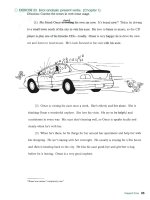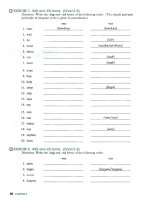Fundamentals of english grammar third edition part 22 potx
Bạn đang xem bản rút gọn của tài liệu. Xem và tải ngay bản đầy đủ của tài liệu tại đây (366.22 KB, 7 trang )
6.
A:
Do you like this tie?
B: Yes.
A:
Do you like that tie?
B: It's okay.
A:
B: This one. (I'm going to buy this one.)
7.
A:
Tony and I went shopping.
I
got some new shoes.
B:
A:
A
tie. (Tony got a tie.)
8.
A:
Did you enjoy your trip to Europe?
B: Yes,
I
did. Very much.
A:
B: Poland, Germany, Czechoslovakia, and Italy. (I visited Poland, Germany,
Czechoslovakia, and Italy.)*
A:
B:
Poland. (I enjoyed visiting Poland the most.)
QUESTION
Whose
asks about possession.*
Notice
in
(a): The speaker
of
the
question may omit the noun
meaning is clear to
COMPARE
(d)
Who's
that?
(e)
Whose
is that?
Mary Smith.
Mary's.
Who's
and
he
have the same
pronunciation.
Who's
=
a contraction of
who
is.
Whose
=
asks about possession.
'See
Charts
6-1 1,
p.
173,
and
6-12,
p.
176,
for
ways
of
expressing possession.
'The diffemce between
what
cmnwy
and
which
coumy
in
often
very
amall.
Asking Questions
135
EXERCISE
20.
Using
WHOSE.
(Chart
5-9)
Directions:
Create questions
with
whose
or
who.
The
things
near Susan belong to her.
The
things
near Eric belong to
hi.
Point to the
things
and people
in
the pictures when
you ask some of the questions.
1.
A:
bhse baskehall
is
this?
B: Susan's. (It's Susan's basketball.)
:
il
.
2.
A:
Uho
is
this?
B: Susan. (This is Susan.)
,
,,
.,
I,
/
3.
A:
that?
B: Eric's. (It's Eric's notebook.)
8E~
.,,.
:
,,&
,z~
J
I$'
,
.
.,
4.
A:
B: Eric's. (They're Eric's tapes.)
5.
A:
that?
.
,
,.;
iT.
>.
B: Eric. (That is Eric.)
,
.,,;a'.
,.i,E!
6.
A:
those?
B: Susan's. (They're Susan's clothes.)
;.,
<.,:,,,
#W~.,P<
7.
A:
that?
B: Susan's. (It's Susan's coat.)
8.
A:
in
a
gym?
B: Susan. (Susan is
in
a
gym.)
.,
.
9.
A:
sitting down?
B: Eric. (Eric is sitting down.)
!
,.>
10.
A:
longer?
B:
Eric's. (Eric's hair is longer than Susan's.)
EXERCISE 21. Using
WHOSE.
(Chart 5-9)
Directions:
Ask and answer questions about possession. Follow the pattern
in
the
examples. Talk about this
in
the classroom.
Example:
pen
SPEAKER
A: Is
this
your pen?
/
Is this (pen) yours?
SPEAKER
B: No, it isn't.
SPEAKER
A: Whose is it?
SPEAKER
B: It's Ali's.
Example:
pens
SPEAKER
A: Are theseYoko's (pens)?
/
Are these @ens) Yoko's?
SPEAKER
B:
NO, they aren't.
SPEAKER
A: Whose are they?
SPEAKER
B:
They're mine.
1. dictionary
5.
bookbag
9.
purse
2. books
6.
briefcase
10, calculator
3.
notebook
7.
glasses 11. things
4.
papers
8.
backpack 12. stuff*
USE
22. Review: information questions. (Charts 5-2
+
5-9)
ma,,
,
:,
.>:
,._:
Dr'reerionc
Work in pairs. Create questions for the given answers. Use any appropriate
question word.
.
.
.
~ ~
~-
""
Example:
I'm reading.
SPEAKER
A: What are you doing?
SPBAKBR
B:
I'm reading.
1.
They're mine.
2. I'm going to smdy.
3.
AToyota.
i
,
4.Mr.(
).
5.
It's
(
.
.
.
1's.
6.
It means "small."
,
.
,
')
Switch roles.
:I
'%>
7.
Jazz.
8.
Because
I
didn't feel good.
9.
This one, not that one.
;
,
.,I
,
.
10.
(
.
.
.
1's.
'I
-'
,,,
,
1 1. A couple of days ago.
,
.
,
'
12. India.
.
.
,
+.,%,.
.LL
,
.,
,
,,
;,
.,.
/.,,
11
,
.
,
,
,
.
.
:
.
,
,:
.
*Smfis
used
in
informal
spoken
English
to
mean
miscellaneous
rhings.
For example,
when
a speaker says, "This
is
my
stuff,"
the
speaker may be
referring
to pens, pencils, books, papers, notebook, clorhes, etc. mote: 8Wis a noncount
noun; ir never has a
final
-6.)
Asking
Questions
137
0
EXERCISE
23.
Asking
questions.
(Charts
5-1
5-9)
Directions:
Work in pairs.
Speaker
A:
Choose any one of the possible answers below and ask a question that would
produce that answer.
Speaker
B:
Decide which answer Speaker A has in mind and answer histher question. Pay
special attention
to
the form of Speaker A's question. Correct any errors.
Alternate asking questions. (First Speaker A asks a question and Speaker
B
answers. Next
Speaker
B
asks a question and Speaker A answers.)
Example:
SPEAKER
A:
What is Maria's favorite color?
SPEAKER
B:
(Speaker
B
reviews the list of possible answers below and chooses the
appropriate one.) Pink.
Fbssible
answers:
Sure! Thanks! Probably.
Call the insurance company.
The teacher's.
Next week. Not that one. The other one.
A rat. A Panasonic or a Sony.
Mr.
( I.
Pink.
Answering your questions. No, a &end of mine gave them to me a few
Cheese. days ago.
Mine. Historical fiction.
Eight-thirty.
Study, and then watch a movie.
Her husband. On the Internet.
5-10
USING
HOW
(a)
How
did you
get
here?
I drove./By car.
I took
a
taxi./Bv taxi.
I
took a bus.& bus.
I flew./Bv olane.
I
I took a *&n./By train.
I walked./On foot.
(b)
How old
are you?
(c)
How
tall
is he?
(d)
How
hip
is your apamnent?
(e)
How sleepy
are you?
(f)
How hungry
are
you?
(g)
How soon
will you be ready?
(h)
How well
does he speak English?
(i)
How
pick&
can you get here?
'henty-one.
About six feet.
It has three rooms.
Very sleepy.
I'm starving.
In five minutes.
Very well.
I
can
get there
in
30
minutes.
How
has many uses. One use
of
how
is to
ask
about means
(ways) of transportation.
How
is often used with
adjectives (e.g.,
old,
b&
and
adverbs (e.g.,
well,
quickly).
EXERCISE
24.
Using
HOW.
(Chart
5-10)
Directions:
Create questions
with
how.
1.
A:
HOW
old
is
yew dawh+ev?
B: Ten. (My daughter is ten years old.)
2.
A:
B: Very important. (Education is very important.)
3.
A:
B:
By bus.
(I
get to school by bus.)
4.
A:
B: Very, very deep. (The ocean is very, very deep.)
5.
A:
B: By plane.
(I'm
going to get to Denver by plane.)
6.
A:
B: Not very. (The test wasn't very difficult.)
7.
A:
B:
It's
29,028
feet
high.
(Mt. Everest is
29,028
feet high.)*
8.
A:
B:
I
walked.
(I
walked to school today.)
-1
1
USING
HOW OFTEN
QUESTION
ANSWER
I
Every day.
Once a week.
(a)
How ofron
do you go shopping? About twice a week.
Every other day or so.*
Three times a month.
@)
How
many
times a
day
do you eat?
Three
or four.
How
many times
a
week
do
you
go
shopping? Two.
How
many
times
a
month
do you go
to the post office?
Once.
How
many
times
a year
do you take
a
once
or
vacation?
How o&n
asks about
frequency.
Other ways of asking
how
oJrsn:
a
day
how
many
times
'Ewv
orhw
dny
means
"Monday
yes,Tuesdsy
no,
Wednesday yes,Thursday
no:'
etc.
Or
so
means
"approximately.'
*29,028
feet
=
8,848
meters.
EXERCISE
25.
Uslng HOW OFTEN. (Chart
5-1
1)
Direchns:
Work in pairs.
Speaker
A.
Ask a question with
how
often
or
how
many times a
daylweeklmonthlyear.
Speaker
B:
Answer the question. (Possible answers are suggested in the list of frequency
expressions.)
Example:
eat lunch at the cafeteria
SPBAKER
A:
HOW often do you eat lunch at the cafeteria?
SPBAKER
B:
About twice a week.
PREQUENCY
EXPRESSIONS
a lot
occasionally*
every
ocher
once in a while
not
vey ofen daylweeklmonthlyear
hardly ever three times
a
almost nwer
ten
times a
never
Switch
roles.
1.
play cards
7.
buy a toothbrush
2.
get on the Internet
8.
go to a laundromat
3.
go out to eat
9.
go swimming
4.
cook your own dinner
10.
be late for class
5.
read a newspaper
1 1.
attend a wedding
6.
get your hair cut
12.
see a falling star
)
It
is
289
mileshm St. Louis
to
Chicago.*
1
st.
Louis to chicapo.
fnnn
Chicago
to
St. Lo&
@)
It
is
289
miles
1-
to
Chicago
hwn
St. Louis.
I
to
St. &isfrom Chicago.
(c)
A:
Howfar
is
it
from St. Louis to Chicago?
B:
289
miles.
(d)
A:
Howfar do
you
live from school?
B:
Four blocks.
(e)
How
many
miles
is it from St. Louis to Chicago?
(f)
How
many
kilometers
is it to Montreal from here?
(g)
How
many
blocku
is
it
to the post office?
*I mile
=
1.60 Homerns.
1 kilometer
=
00.614 mile.
The
most common way of expressing distance:
It
is
+
distnnce
+fromlto
+
tolfrom
In
@):
AU
four expressions withfrom and
to
have the same meaning.
Howfar
is used to ask questions about
distance.
Other ways to ask
howfar:
hour
many miles
how
many kilometers
how
many
block
'Notice:
Occasionally
is
spelled
with
nu,
"c"s
but
only
one
"s."
140
CHAPTER
5
EXERCISE
26.
Uslng
HOW
FAR.
(Chart
5-12)
Directions
Create questions.
How
Gav
is
it to
f
K
1.
A:
team
how
New
orleaw?
B: 919 miles. (It's 919 miles to Chicago from New Orleans.)
2.
A:
B:
257
kilometers. (It's
257
kilometers from Montreal to Quebec.)
3.
A:
B:
Six
blocks. (It's six blocks to the post office.)
4.
A:
I
had a terrible day yesterday.
B:
Whathappened?
A:
I
ran out of gas while
I
was driving to work.
B
:
before you ran out of gas?
A:
To the junction of 1-90 and 480. (I got to the junction of 1-90 and 480.) Luckily,
there was a gas station about half a mile down the road.
EXERCISE
27.
Uslng
HOW
FAR.
(Chart
5-1
2)
Directions:
Bring
road maps of your geographical area to class.
In
small groups, look at
a
map of your area and ask each other questions with
how
far.
-
1
5-13
LENGTH
OFTIME:
IT
+
TAKE
AND
HOW
LONG
IT
+
TAKB
+
(SOMEONE)
+
LENGTH
+
-
OF
TIME
(a)
It
takes 20 minutes
to
cook
rice.
(b)
It
took
Al
two hours to
driwe
to work.
(c)
How
long
does it
take
to cook rice? -20 minutes.
(d)
How
long
did it take
Al
to drive to work today? -7ko hours.
(e)
How
long
did you study last
night?
-Four hours.
(f)
How
long
will you be
in
Hong Kong? -Ten days.
(g)
How
many
days
will you
be
in Hong Kong?
rn
It
+
is often used
wit'
'
e
words and
an
infinitive to express
length
of
the,
as in
(a)
and
(b).
An
infinitive
=
to
+
the
simpleform
of
a
wet+.*
In
(a):
to
cook
is an infinitive.
How
long
asks about
length
of
time.
Other ways of asking
how
long:
minures
hours
Asklng
Questions
141









